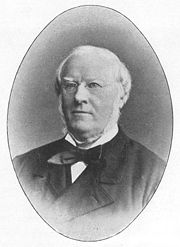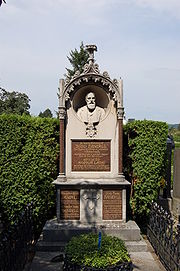
John Haswell
Encyclopedia


He was born on 20 March 1812 in Lancefield, Glasgow, Scotland
Scotland
Scotland is a country that is part of the United Kingdom. Occupying the northern third of the island of Great Britain, it shares a border with England to the south and is bounded by the North Sea to the east, the Atlantic Ocean to the north and west, and the North Channel and Irish Sea to the...
, studied at Anderson's University in Glasgow
Glasgow
Glasgow is the largest city in Scotland and third most populous in the United Kingdom. The city is situated on the River Clyde in the country's west central lowlands...
and worked for 22 years in the shipbuilding office of William Fairbairn
William Fairbairn
Sir William Fairbairn, 1st Baronet was a Scottish civil engineer, structural engineer and shipbuilder.-Early career:...
& Co.
In 1837 at the prompting of Matthias Schönerer, who was also heavily involved in the Budweis–Linz
Linz
Linz is the third-largest city of Austria and capital of the state of Upper Austria . It is located in the north centre of Austria, approximately south of the Czech border, on both sides of the river Danube. The population of the city is , and that of the Greater Linz conurbation is about...
–Gmunden
Gmunden
Gmunden is a town in Upper Austria, Austria in the district of Gmunden. It has 13,202 inhabitants . It is much frequented as a health and summer resort, and has a variety of goat, lake, brine, vegetable and pine-cone baths, a hydropathic establishment, inhalation chambers, whey cure, etc...
wagonway
Wagonway
Wagonways consisted of the horses, equipment and tracks used for hauling wagons, which preceded steam powered railways. The terms "plateway", "tramway" and in someplaces, "dramway" are also found.- Early developments :...
, he drew up plans for the repair shop of the Wien-Raaber railway (later Lokomotivfabrik der StEG
Lokomotivfabrik der StEG
In 1839 the Lokomotivfabrik der StEG became the first Austro-Hungarian locomotive works to be founded and it produced many influential locomotive designs....
), and in 1839 became entrusted with carrying them out, along with the mechanical engineer Kraft. When the workshop had been built, the first of its kind in Austria, he took over its management and oversaw, not just repair work, but also the construction of new rolling stock for the railway.
Inter alia he was responsible for:
- the first six-coupled steam locomotiveSteam locomotiveA steam locomotive is a railway locomotive that produces its power through a steam engine. These locomotives are fueled by burning some combustible material, usually coal, wood or oil, to produce steam in a boiler, which drives the steam engine...
in AustriaAustriaAustria , officially the Republic of Austria , is a landlocked country of roughly 8.4 million people in Central Europe. It is bordered by the Czech Republic and Germany to the north, Slovakia and Hungary to the east, Slovenia and Italy to the south, and Switzerland and Liechtenstein to the...
FAHRAFELD (1846) - participating in the SemmeringSemmering RailwayThe Semmering railway, Austria, which starts at Gloggnitz and leads over the Semmering to Mürzzuschlag was the first mountain railway in Europe built with a standard gauge track. It is commonly referred to as the world's first true mountain railway, given the very difficult terrain and the...
competition in 1851 with the locomotive VINDOBONA, a model for the subsequent Engerth mountain locomotivesEngerth locomotiveThe Engerth locomotive was a type of early articulated steam locomotive designed by Wilhelm Freiherr von Engerth for use on the Semmering Railway in Austria.- Designer :... - the first eight-coupled, steam locomotive in Austria WIEN–RAAB (1855), the pattern for heavy freight locomotives on the continent for many years
- the steam brakeSteam brakeA steam brake is a type of brake for steam locomotives and their tenders, whereby a steam cylinder works directly on the brake linkages.Steam brakes were primarily used on railways where vacuum brakes were used to brake the train, but where there was no vacuum brake on the steam locomotive itself,...
first used on the STEYERDORF (1861) - the first four-cylinder locomotive, the DUPLEX (1861)
- the hydraulic forging press (1862), that first enabled the forging of heavy machine components in dies (today at the Vienna Museum of TechnologyTechnisches Museum WienThe Technisches Museum Wien lies in Vienna , in Penzing district, on the Mariahilferstraße 212....
) - Corrugated iron firebox (1872)
In 1882 Haswell resigned from his position. He died on 8 June 1897 in Vienna
Vienna
Vienna is the capital and largest city of the Republic of Austria and one of the nine states of Austria. Vienna is Austria's primary city, with a population of about 1.723 million , and is by far the largest city in Austria, as well as its cultural, economic, and political centre...
and rests in a grave dedicated to his honour at the Döbling Cemetery (Group 10, number 1) in Vienna.
Source
- Karl GölsdorfKarl GölsdorfKarl Gölsdorf was an Austrian engineer and locomotive designer.-Early Life:Karl Gölsdorf was born on 8 June 1861 in Vienna, the son of Louis Adolf Gölsdorf. Even as a schoolboy he was introduced to locomotive design by his father, the chief mechanical engineer of the Imperial and Royal Southern...
: Lokomotivbau in Alt-Österreich 1837–1918. Verlag Slezak, Wien 1978, ISBN 3-900134-40-5.
External links
- There is a relevant English-language forum at Railways of Germany

